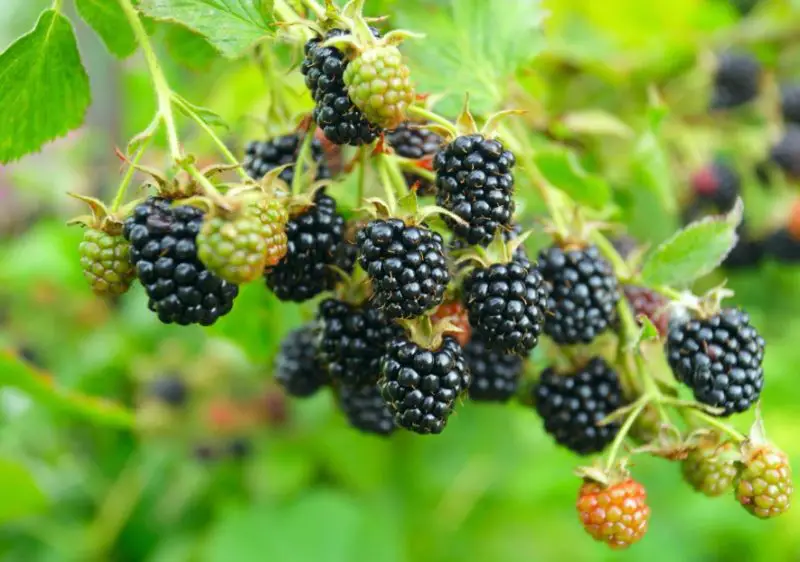The Triple Crown Blackberry is a gardener’s favorite for its high-yielding and easy-to-grow characteristics. Known for its thornless canes, sweet and juicy berries, and hardy growth, the Triple Crown Blackberry is a great addition to any home garden or commercial farm.
In this comprehensive guide, we’ll cover everything you need to know about growing, caring for, and harvesting Triple Crown Blackberries to ensure a thriving crop.
What is the Triple Crown Blackberry?

The Triple Crown Blackberry (Rubus fruticosus) is a type of thornless blackberry developed by the USDA and named for its “three crowns” of flavor, productivity, and vigor. Introduced in the early 1990s, this blackberry variety quickly became popular for its deliciously sweet berries and high yield.
Key Features of Triple Crown Blackberry
- Thornless Canes: No thorns make it easier to harvest and maintain.
- Vigorous Growth: These plants are known for producing large, healthy canes.
- Extended Harvest Season: The Triple Crown Blackberry has a longer harvesting window, typically lasting from late July to August.
- Sweet Taste: Known for its rich, juicy flavor, this berry is a favorite for fresh eating, jams, and desserts.
Planting Triple Crown Blackberries
Planting Triple Crown Blackberries involves choosing the right location, preparing the soil, and knowing the optimal planting time. Here’s a step-by-step guide to setting up a successful blackberry patch.
Choosing the Right Location
Triple Crown Blackberries thrive in full sunlight. Ensure they receive at least 6-8 hours of sunlight daily for the best fruit production. This variety also requires good air circulation to prevent diseases.
Soil Preparation
Triple Crown Blackberries do best in well-draining, loamy soil with a pH between 5.5 and 7.0. Conduct a soil test to check the nutrient levels and pH. If the soil is too acidic, adding lime can help balance the pH, while adding sulfur can help lower it if too alkaline. Compost or aged manure can enhance soil fertility, promoting healthy growth and abundant fruiting.
Planting Process
- Timing: Plant Triple Crown Blackberries in early spring when the risk of frost has passed.
- Spacing: Space the plants about 3-5 feet apart in rows with at least 8-10 feet between rows to allow ample room for growth and harvesting.
- Depth: Dig a hole that’s deep enough to accommodate the root system and place the plant inside, covering the roots with soil. Water well after planting to help settle the soil.
Caring for Triple Crown Blackberries
Proper care and maintenance are essential for a healthy blackberry plant. Here are some tips for watering, fertilizing, pruning, and supporting your Triple Crown Blackberry.
Watering
Triple Crown Blackberries require consistent moisture, especially during the growing and fruiting seasons. Water deeply, aiming for 1-2 inches per week. Use mulch around the base of each plant to help retain moisture and control weeds, applying it in a 2-3 inch layer.
Fertilizing
Fertilize your Triple Crown Blackberry in early spring before new growth appears. Use a balanced fertilizer with an N-P-K ratio like 10-10-10. Reapply fertilizer every year to maintain strong growth and high yields. Be mindful not to over-fertilize, as too much nitrogen can promote excessive leaf growth at the expense of fruit production.
Pruning
Pruning is crucial for managing plant size and encouraging better fruit production. There are two main types of pruning to consider:
- Primocane Pruning: In late winter or early spring, trim new canes (primocanes) to a manageable height (4-5 feet). This promotes lateral branching, where the berries will eventually grow.
- Floricane Pruning: After harvesting, prune the second-year canes (floricanes) down to the ground. Floricanes only produce fruit once, so removing them prevents crowding and allows new primocanes to grow.
Supporting and Training the Canes
Using a trellis system is beneficial for keeping the canes upright and making harvests easier. Install sturdy posts with wires or strings spaced at 12-18 inches apart for the canes to lean on. Tying the canes to the trellis also improves air circulation and reduces the risk of diseases.
Pest and Disease Management
Triple Crown Blackberries are generally resilient but can still encounter pests and diseases. Here are some common issues and tips on how to manage them effectively.
Common Pests
- Aphids: Tiny insects that can cause yellowing leaves. Use insecticidal soap or introduce ladybugs as natural predators.
- Spider Mites: These can cause leaf discoloration. Regularly spray the plants with water and apply neem oil if infestations become severe.
- Japanese Beetles: These beetles feed on foliage and can be controlled by using hand-picking, or applying insecticidal sprays specifically for beetles.
Common Diseases
- Anthracnose: A fungal disease that causes small spots on leaves and canes. Prune affected areas and use copper-based fungicides as needed.
- Botrytis (Gray Mold): Often occurs in humid conditions, affecting fruit quality. Good air circulation and proper spacing can help prevent this, along with removing any infected berries.
- Verticillium Wilt: This soil-borne disease causes wilting and can be hard to control once present. Rotate your plants every few years to prevent soil-borne diseases.
Regularly inspect your plants, as early detection and quick intervention are key to keeping your Triple Crown Blackberries healthy.
Harvesting Triple Crown Blackberries
Triple Crown Blackberries produce fruit in their second year. Here’s a guide to knowing when and how to harvest your berries.
When to Harvest
Triple Crown Blackberries typically ripen from late July to August. Berries are ready to be picked when they are fully black, plump, and easily detach from the plant. Harvesting every few days during peak season ensures you get the ripest, sweetest berries.
How to Harvest
Gently twist the berry while pulling it off the cane. Avoid squeezing, as this can damage the fruit. Harvest in the cooler hours of the day to maintain the freshness and quality of the berries.
Storing and Using Triple Crown Blackberries
Freshly picked blackberries can last in the refrigerator for 3-5 days. For longer storage, freeze the berries by placing them on a baking sheet in a single layer and then transferring them to an airtight container once frozen.
Triple Crown Blackberries are incredibly versatile and can be used for:
- Jams and jellies
- Smoothies
- Baked goods like pies, cobblers, and muffins
- Fresh eating or as a topping for cereals and desserts
Tips for Maximizing Triple Crown Blackberry Yield
For the best harvests, follow these advanced tips to get the most out of your Triple Crown Blackberry plants:
- Rotate the Growing Area: If possible, rotate blackberry planting areas every few years to prevent soil depletion and reduce disease buildup.
- Avoid Overcrowding: Proper spacing encourages healthier plants, increased sunlight exposure, and air circulation.
- Proper Pruning Techniques: Pruning at the right time allows the plant to focus its energy on fruit production rather than excess leaf growth.
- Adequate Winter Protection: If you live in colder zones, protect your blackberries by adding an extra layer of mulch or covering them with frost cloths during extreme cold spells.
Frequently Asked Questions (FAQs)
How long do Triple Crown Blackberries take to bear fruit?
Triple Crown Blackberries generally bear fruit in their second year after planting. The plant produces fruit annually thereafter, with high yields as it matures.
Can Triple Crown Blackberries be grown in containers?
Yes, they can! Use a large container (at least 15-20 gallons) with well-draining soil and place it in a sunny area. Container-grown blackberries may need extra watering and fertilizer compared to those grown in the ground.
Do Triple Crown Blackberries need cross-pollination?
Triple Crown Blackberries are self-pollinating, meaning they don’t require another plant to produce fruit, though having multiple plants can increase yield.
By following these detailed steps, you can enjoy a bountiful harvest of Triple Crown Blackberries each year. With proper care, watering, pruning, and disease management, these berries will reward you with an abundance of delicious, home-grown fruit!






